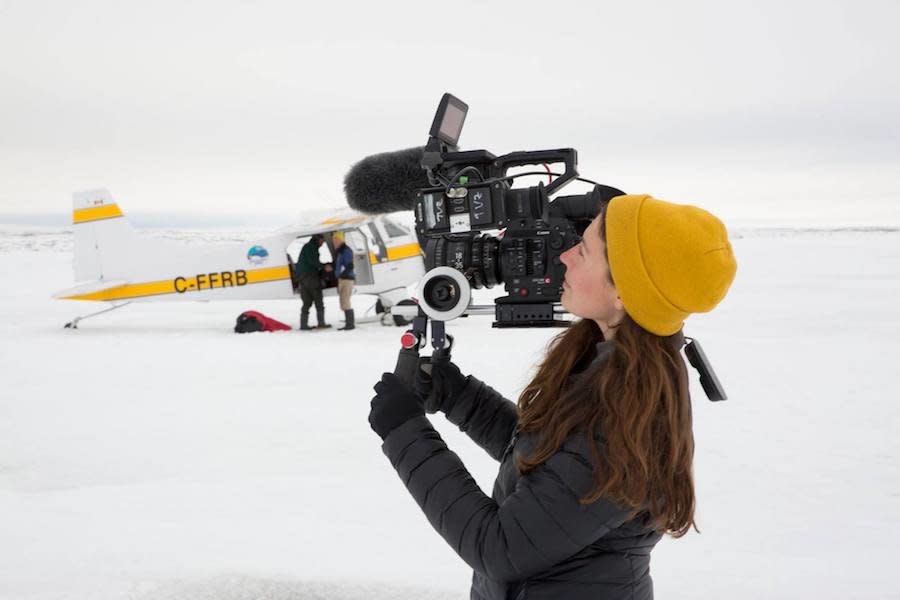This woman is fighting climate change by documenting it
In our Working Girl Diaries series, accomplished women with fascinating careers let us peek into three days of their lives.
April 22nd is Earth Day, an important reminder to celebrate environmental protection around our entire planet—something we should already be doing on the daily . As scientists and conservations fight America’s anti-scientist government to merely recognize the irreparable damage of climate change so that we can save what’s left of our earth, it’s always necessary to uplift their work. That’s why, for this month’s Working Girl Diaries, we’re bringing you three days in the life of Tasha Van Zandt.
Tasha Van Zandt is a conservation photographer and filmmaker, specifically documenting climate change in order to bring attention to its devastation. A director and cinematographer, Van Zandt walked away from her career as an ad agency art director so that she could devote herself to environmental advocacy and documentation. Now you can see Van Zandt’s jaw-dropping photography in National Geographic, Time, The Guardian, Google, and Adobe Stock, among other international publications. She is also a filmmaking and photography instructor for National Geographic Expeditions, leading educational voyages in Japan, Iceland, Tanzania, and Australia.
Van Zandt has already documented and researched the dangers of coral bleaching at the Great Barrier Reef, the threat of leftover explosives (UXOs) from the Vietnam War that still pose a threat to the Lao people, the lives of Buddhist monks at the Thai-Myanmar border, and the existence of bedouin villages in the Negev. Now, Van Zandt is aboard the National Geographic Explorer ship traveling through Antarctica and documenting how climate change has harmed the continent’s environment and wildlife for a film called After Antarctica.
The documentary follows Will Steger, one of National Geographic’s most celebrated polar explorers and a climate change activist. In 1989, Steger traveled with a team to Antarctica for history’s longest expedition through the region. But as Van Zandt writes in her diary for HG, “The three ice shelves that the team crossed have all disintegrated—leaving them as not only the first team to complete this historic feat, but the last.” Van Zandt is documenting Steger’s return to Antarctica 30 years later in order to educate viewers on global warming’s destruction of the continent.
Keep reading to get a glimpse into three days of Van Zandt’s life aboard the Explorer ship, and be sure to visit her Instagram to see even more of the work she is doing to protect our planet.
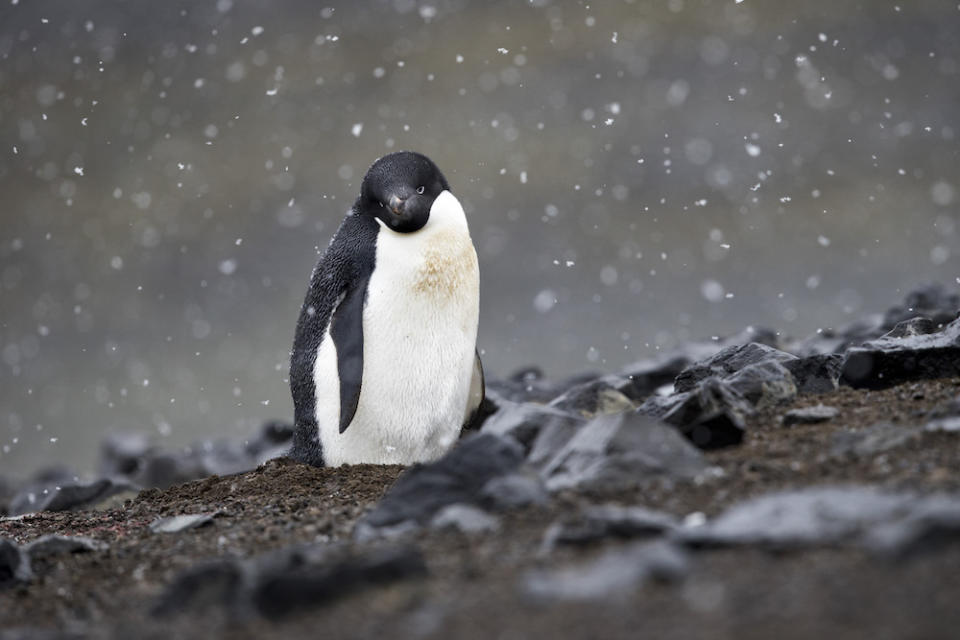
Day 1:
6:30 a.m.: I’m currently aboard the National Geographic Explorer ship on my way to Antarctica. This morning I awake to our captain’s voice on the intercom announcing, “Whales ahead!” I leap from my bed, quickly springing into action, grabbing my camera, and heading to the bow of the ship. We have a nearly hour-long encounter with many fin and humpback whales. A great way to end our dreaded traverse over the Drake Passage as we near the Antarctic Peninsula for our first stop.
8:30 a.m.: After the excitement of documenting the whales, I go to the glass-enclosed library for some morning tea and breakfast, and watch the continent begin to fill the horizon. I’m currently in Antarctica for the documentary film I’m directing, so this rare moment of downtime is the perfect opportunity to review and revise my shot list for the day.
While looking out at the changing landscape, it feels very energizing to be free from the two-plus days of travel over the dangerous Drake Passage. Many sailors perished in these waters trying to “round the horn,” and nearly 800 shipwrecks have been documented in the area. Nearing the Peninsula feels like a breath of fresh air, and everyone’s excitement is building over what the continent will bring.
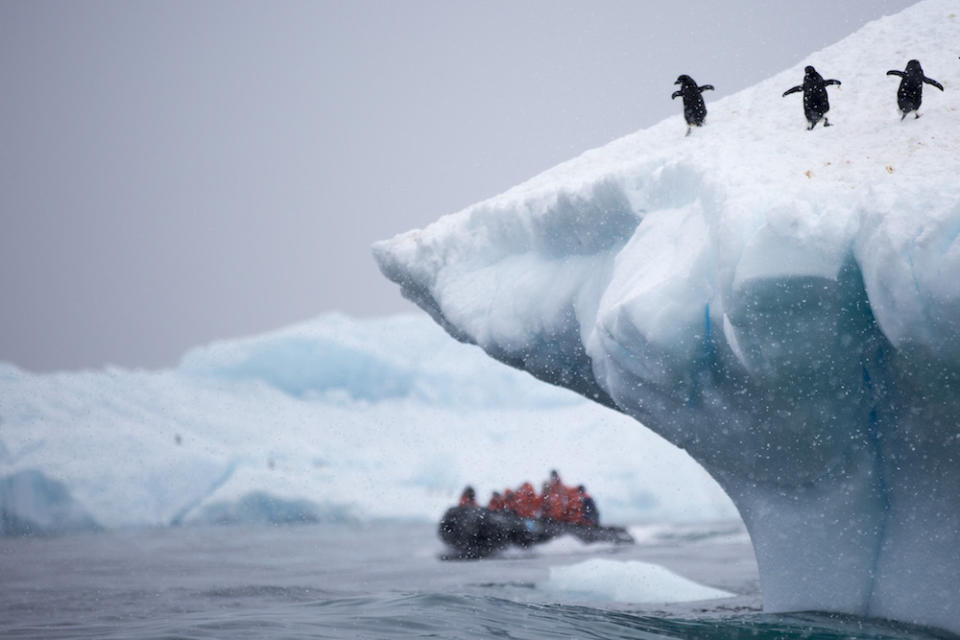
10:30 a.m.: I head to the bridge of the ship to film Will Steger discussing our route for the day with the captain. Our film follows one of National Geographic’s most accomplished polar explorers, Will Steger, who in 1989 led an international team on the longest crossing of the continent. During the 30 years since that expedition, the three ice shelves that the team crossed have all disintegrated—leaving them as not only the first team to complete this historic feat, but the last. We are journeying back to the continent with Steger to witness these changes firsthand.
12:30 p.m.: Today will be our first landing of the expedition, and to say I’m excited is an understatement. Today will also officially mark the seventh continent that I’ve traveled, which has always been a lifelong dream. I head down to the loading room on the ship to decontaminate my gear before boarding a Zodiac boat, which will take my filmmaking partner and I from ship to shore. Decontamination and biosecurity are crucial parts of the process for visitors to help keep this beautiful place pristine. I load my cinema camera into the Zodiac as it bobs wildly, then quickly jump in. A flurry of snow is falling rapidly around us and the waves splash as we speed to shore. Once we’ve arrived, I step my waterproof boots into the water and unload the gear, fearing that I’ll accidentally drop my equipment into the small waves around me. Thankfully, all the gear makes it to shore, and my partner and I start setting up the camera while curious Chinstrap penguins surround us.
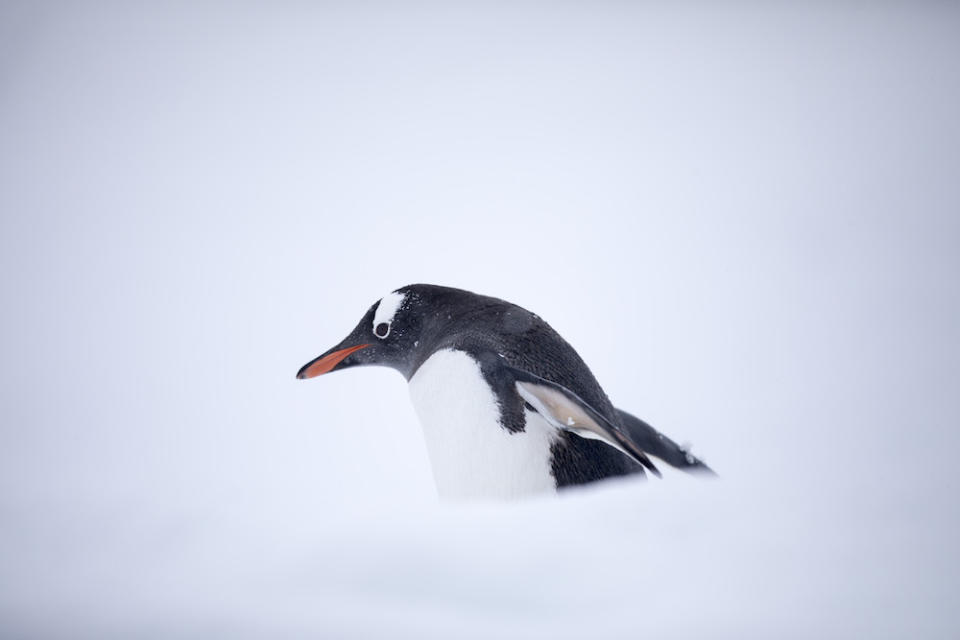
2:30 p.m.: We are currently exploring the Argentine Station at Half Moon Island, which is a minor Antarctic island in the South Shetland Islands of the Antarctic Peninsula. We’ve been focusing on capturing footage of the penguins in this surreal landscape, and once we’ve got all the footage we need, we re-board the Zodiac boat (which is a journey in and of itself). Once we’re back on the National Geographic Explorer ship, we head back into the decontamination room for biosecurity.
4:30 p.m.—6:30 p.m.: We download the footage from our first stop and recharge all of our gear before the next round of filming. I head down to the main dining room for dinner with the crew and we look at the map outlining the next day’s route.
8:30 p.m.: After dinner, my partner and I prep our gear for the next day. Once everything is ready, I pull out my still camera and we head up to the bow of the ship to document the incredible landscape surrounding us. The sun doesn’t set in Antarctica at this time of year, so the bright light disorients me and gives me energy to keep shooting for the next several hours. We pass by numerous seals, sea lions, and penguins resting atop the ice flow.
10:30 p.m.: Back in my cabin, I download my remaining footage from the day, drink some tea to wind down, and then it’s lights out.
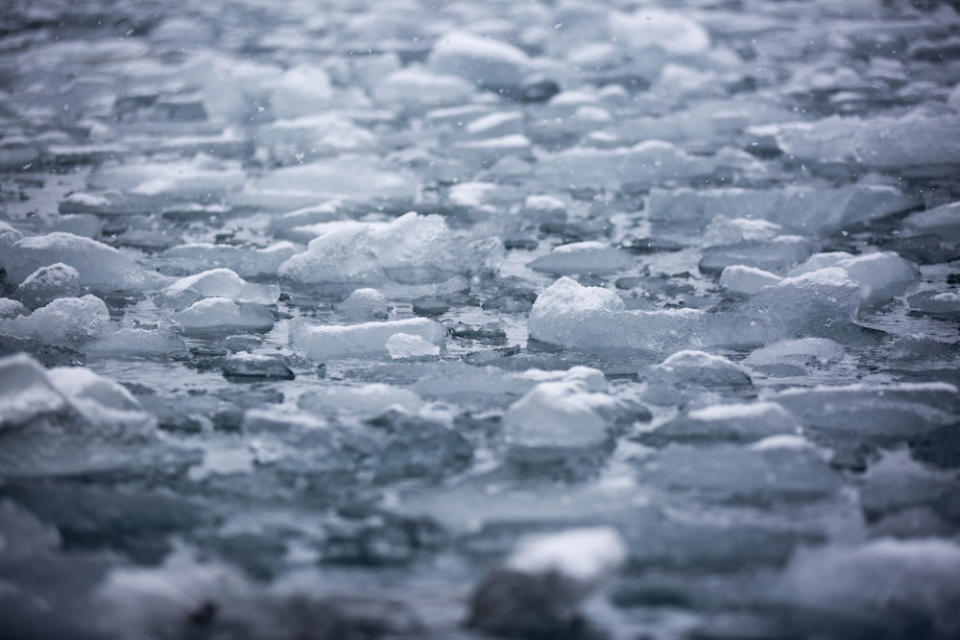
Day 2:
6:30 a.m.: Again, I awake to the Expedition Leader’s voice drifting through the intercom in my cabin, this time announcing that we are nearing Brown Bluff—our first stop of the day. I scramble to suit up as quickly as possible before grabbing my camera and rushing over for decontamination so that we can board the first available Zodiac.
7:30 a.m.: We repeat the adrenaline-filled process of throwing our equipment into the rocky boat, cruise around Brown Bluff, and see a variety of ice formations topped with numerous Adélie penguins. It’s a stunning landscape, and we use the opportunity to film an interview with Will Steger while penguins gather around the small boat. It’s potentially a great moment for the film.
10:30 a.m.: After we head back to the ship and decontaminate, I grab a quick tea and get to work researching in the ship’s library. We’re setting sail into the Weddell Sea in hopes of landing at Devil Island. Along the way, our captain announces that the Explorer’s sister ship, the National Geographic Orion, is nearby, so we go to the bow of our ship to say hello. I wave across the way to several colleagues from National Geographic Expeditions.
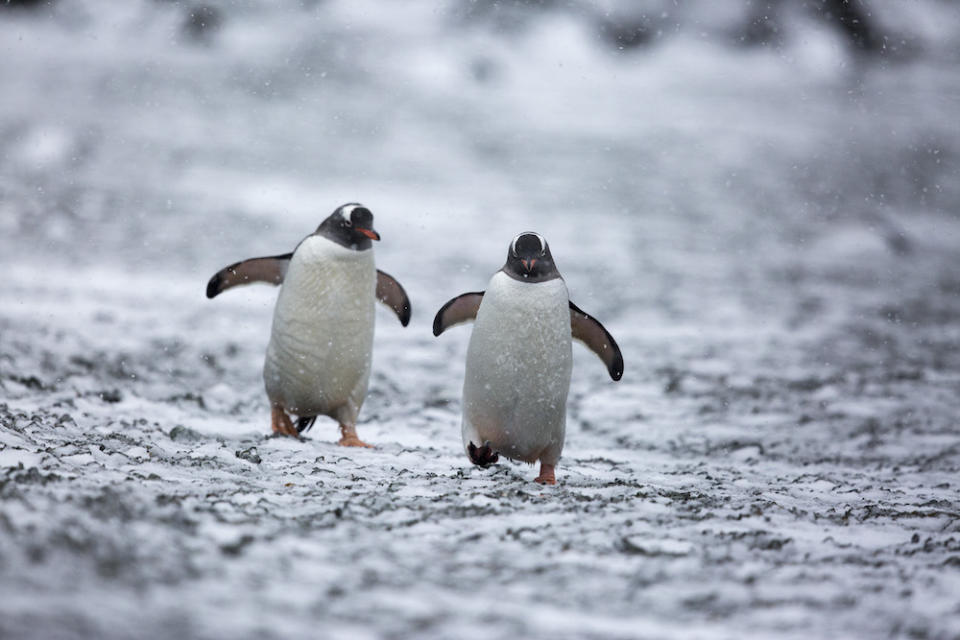
12:30 p.m.: The heavy ice conditions that the Weddell Sea is known for are kind to our crew, allowing us to reach Devil Island. Upon landing, we go hiking, visit another Adélie penguin colony, and film a powerful scene for the documentary in which the weather conditions quickly turn into a blizzard, adding a stunning visual layer to the footage.
4:30 p.m.-6:30 p.m.: After once again downloading the footage and recharging all of the gear—practically a full-time job in itself—I go back to the library. I’m using the ship’s exceptionally slow satellite internet to submit a grant application for the film and review footage from the day. Later I grab a plate of food and plan the next day’s route with the captain.
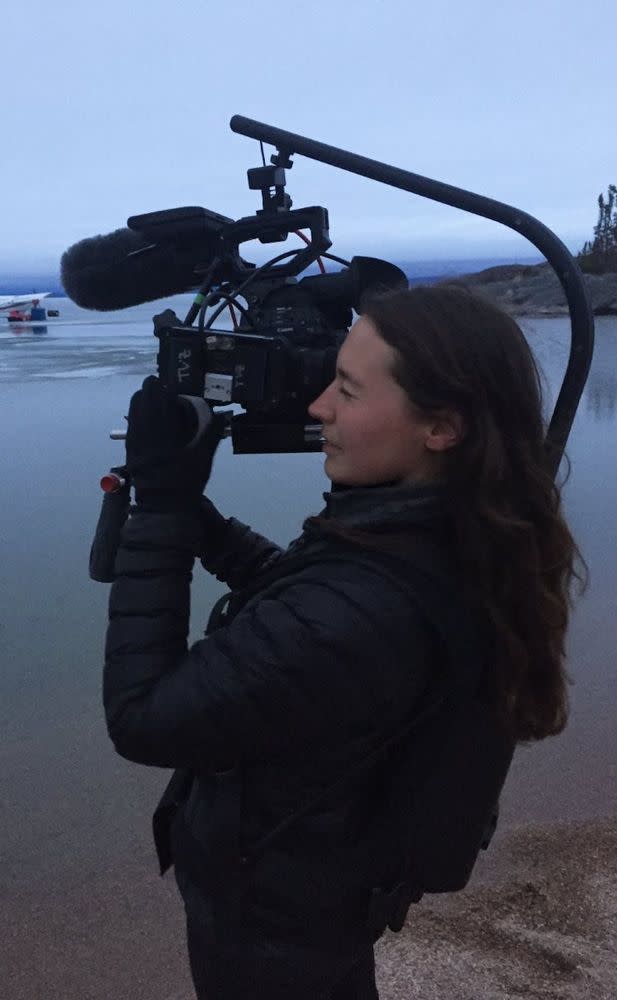
8:30 p.m.: Today is the southern solstice—Antarctica’s longest day of the year—so it’s fitting that it’s quite a full day for us. In honor of the solstice, the ship’s captain decides that, after dinner, we’ll park the Explorer in fast ice and enjoy hiking on the ice itself. We disembark the ship and tread carefully on the ice. We film a quick interview with Will Steger, but any movement proves difficult given how rapidly the ice turns to slush. We re-board the ship, download footage, recharge all gear, and head up to the bow to take stills of stunning pink and purple sky.
10:30 p.m.: After all gear is prepped for the next day, I return to my cabin for a cup of tea and watch the bright pink sky reflecting on the waves through my room’s porthole. We’re headed off to our next destination.
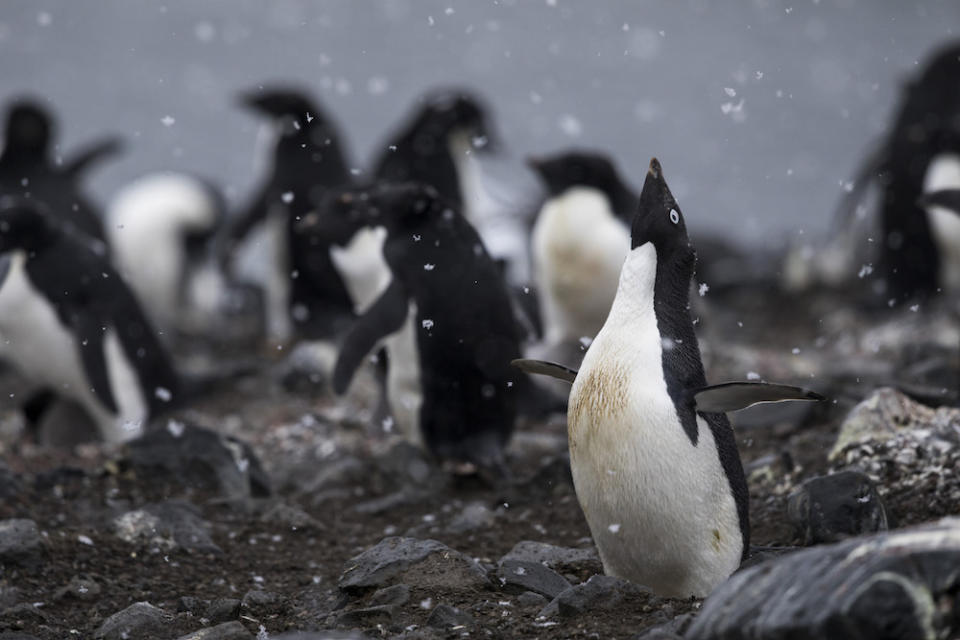
Day 3:
6:15 a.m.: I hear my daily wakeup call—the Expedition Leader’s voice drifting through the intercom—announcing to the ship that we are nearing our first stop of the day. After several days of atmospheric mist, fog, and snow, we awake to sunlight sparkling off the waves, icebergs, and distant mountains.
I begin to suit up and pack equipment for the day, then grab a quick plate of breakfast and cup of tea in the ship’s galley.
8:30 a.m.: Due to the icy conditions, we turn away from our original destination, Snow Hill Island, and head towards Cockburn Island instead. Cockburn Island is an entirely volcanic formation known as a moberg or tuya. I’m at the desk in my cabin, reviewing our footage so far as the view of the island fills up my porthole window.
10:30 a.m.: My team and I finish getting ready in the decontamination room, board the Zodiac, and cruise along the coast to film more landscape and wildlife footage. It is fascinating to document this extinct, under-ice volcano and view the numerous wildlife surrounding it. We film with Will Steger and fly our drone for aerial footage (thanks to support from IATO).
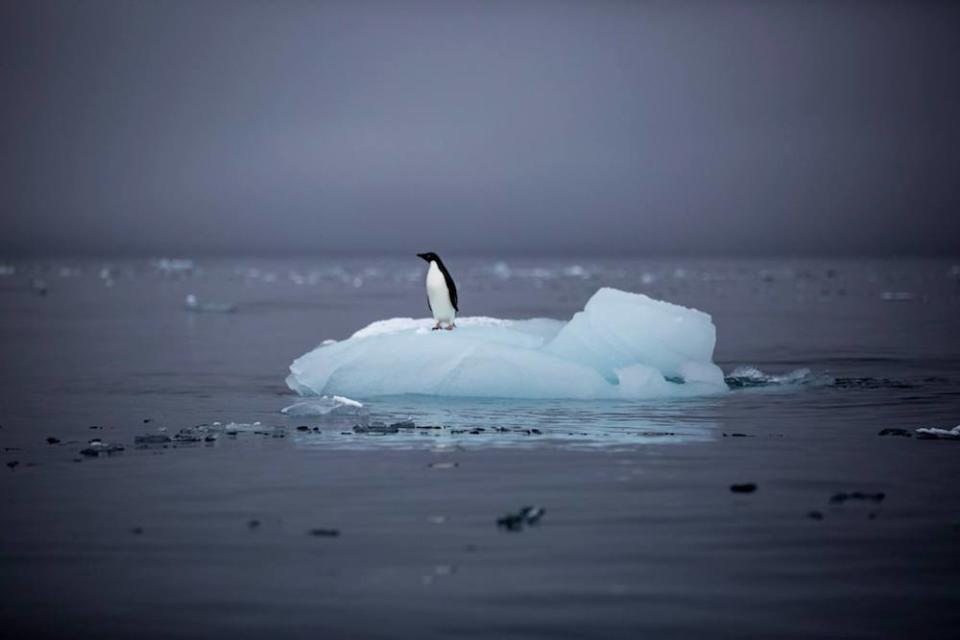
2:30 p.m.: Back on the ship, I head up to the library for some much-needed caffeine and sort through our newly downloaded footage. Next, I head to the bridge and film our Will Steger discussing the original 1989 expedition route and how the environment has changed since then. The ship begins to rock as the waves grow larger on our way towards the Lemeire Channel. I head back to the cabin to revise my interview questions for the rest of the day and the rough waters calm.
4:30 p.m.: Our ship approaches the Lemeire Channel. The water is stunningly still as we glide past Kodak Gap. I suit up quickly and rush to the bow of the ship to film for the documentary and take still photographs for a photo book I am creating alongside the film. Spirits are high aboard the ship as we spot numerous wildlife and take in the dramatic landscape.
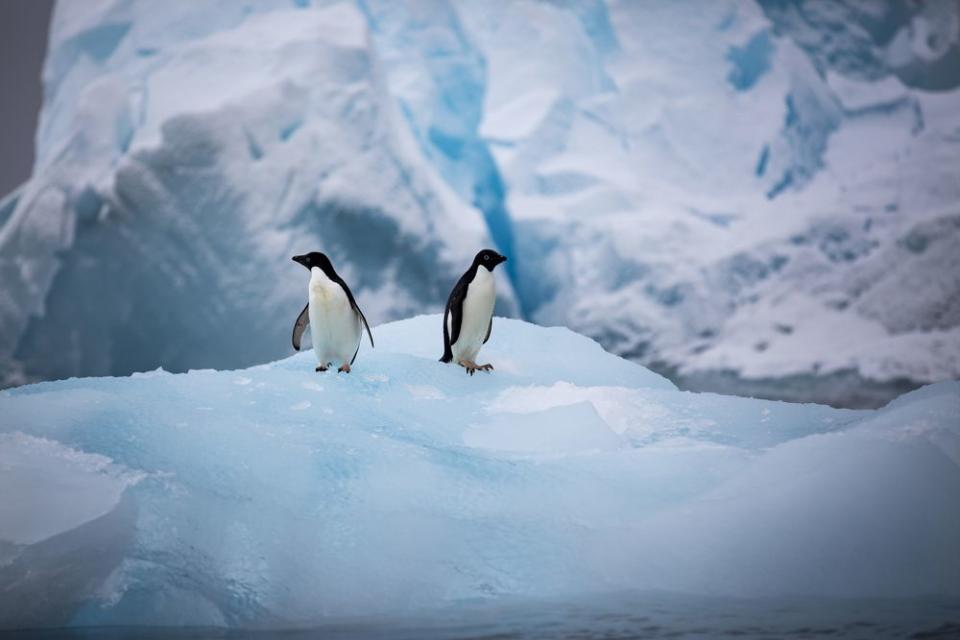
7:30 p.m.: We download our footage and recharge yet again, then head over to the dining hall to eat with the guests and crew. The brilliant pink sky and the vibrant blue ice makes for a beautiful contrast. There is a warm breeze in the air in comparison to Antarctic standards, so I head out to the bow of the ship and watch the colors of the sky change. The Antarctic sun keeps me wide awake, so I head back to the window-filled library to research for the film.
10:30 p.m.: I head back to my cabin and watch the waves before closing my porthole window. I make sure all gear is charged and prepped for tomorrow, then it’s lights out before the next adventure.
For more Working Girl Diaries, check out:
This woman’s job is studying why online dating can suck, and making it better
What it’s like to be a woman leading TV development at Hulu
And see more here.
